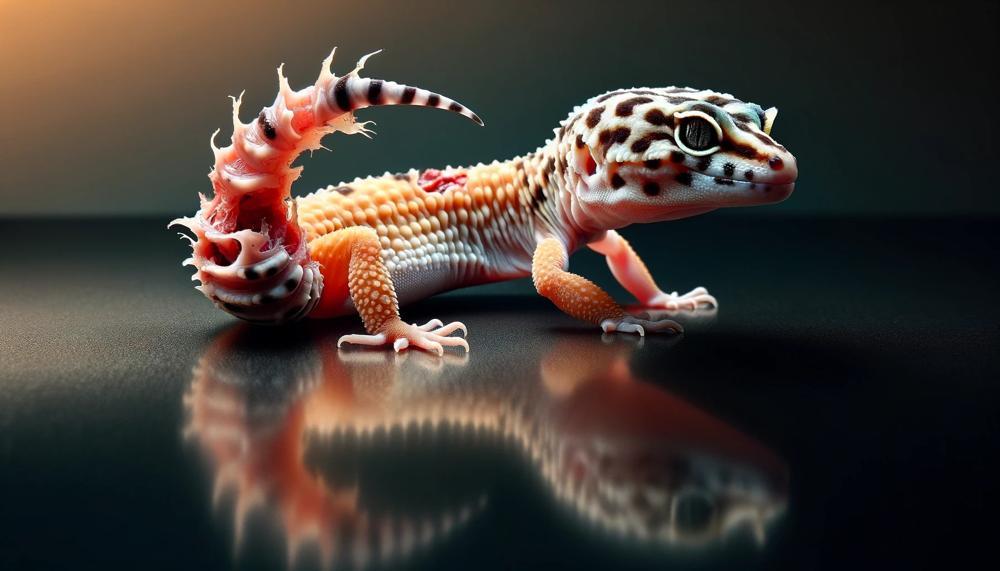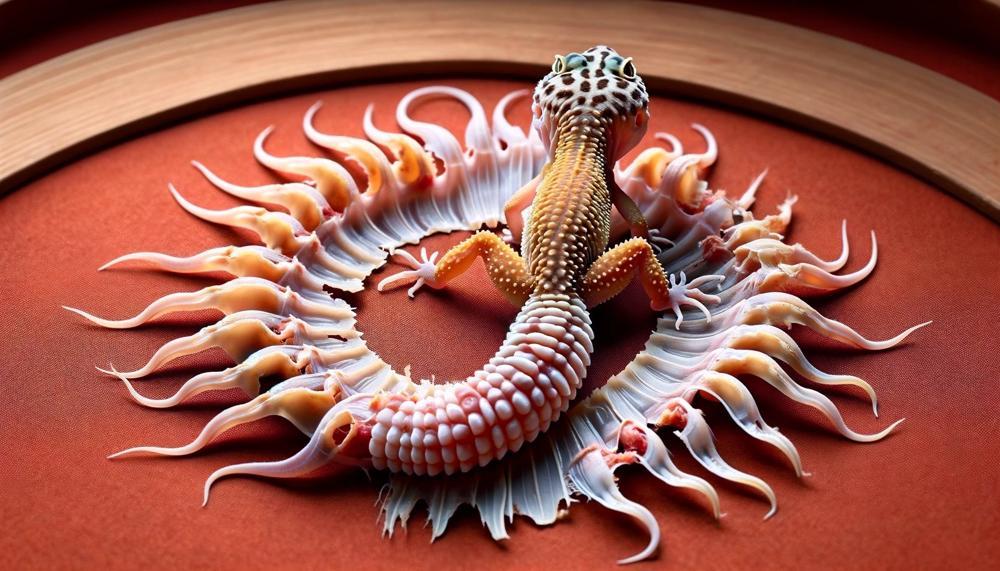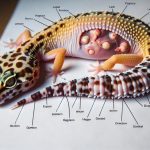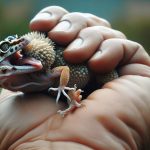With their striking appearance and unique defense mechanism of tail shedding, leopard geckos have long been a fascination for reptile enthusiasts.
But have you ever wondered about the consequences of this adaptation on these beloved creatures? In this blog post, we’ll dive into the world of leopard geckos and uncover the truth about whether they feel pain when they lose their tails.
From the reasons behind tail shedding to the potential impact on geckos in captivity, we’ll leave no stone unturned. So, does it hurt a leopard gecko to lose its tail?
a gecko shouldn’t experience pain when it loses its tail. Geckos drop their tails as a defense mechanism when they feel threatened or are grabbed by the tail. This process is known as autotomy. The tail will continue to move after detaching, which distracts the predator while the lizard makes its escape. However, tail dropping puts stress on a gecko and may impact its health. The process generally takes 30-40 days and can be very taxing on the animal’s body.
Let’s begin.
Contents
What is leopard gecko tail drop?
Leopard geckos possess the unique ability to voluntarily drop their tails as a defense mechanism against predators. This process, known as caudal autotomy, involves the detachment of the tail from the body in order to distract or escape from danger. Additionally, leopard geckos may also shed their tails to free themselves from tight spaces or to heal from an illness.
The process of tail-dropping is not a painful one for leopard geckos due to their specialized biology. Their tails are designed to easily detach, containing specialized muscle tissue that contracts when threatened, making it simpler for the tail to break off. This process also triggers the release of endorphins, natural painkillers that help alleviate any discomfort or pain.
However, it is crucial to address the root cause of tail-dropping, such as stress or improper environmental conditions. If a leopard gecko feels constantly threatened or stressed, it may resort to shedding its tail more frequently. Therefore, providing a clean and safe environment along with a nutritious diet can help prevent excessive tail-dropping.
In case your leopard gecko does drop its tail, proper care during the regrowth process is essential. This includes keeping the enclosure clean and free of any potential hazards that could lead to infection or delay the regrowth. It generally takes 2-3 months for a leopard gecko to regrow its tail, but older geckos may take longer and may remain tailless for the rest of their lives.
Do leopard geckos drop their tails?
Yes, they do. This process is known as autotomy and involves the contraction of muscles and breaking of weak points in the tailbone. While this may seem alarming to owners, it is a natural and painless process for the gecko.
The primary purpose of tail dropping is to distract predators and allow the gecko to escape. However, there are other factors that can trigger this behavior, such as stress from environmental conditions like extreme humidity or temperature. To prevent a chain reaction of tail drops in multiple geckos, it is important to separate potential victims from the group.
Furthermore, the design and maintenance of the enclosure can play a role in preventing tail drops. Tight corners and potential falling objects can cause a gecko’s tail to get stuck, so it is crucial to design the habitat with this in mind. Regularly inspecting and maintaining the enclosure can also help prevent a stuck tail.
Stress and fear are major factors that can lead to tail dropping in leopard geckos. Therefore, it is essential for owners to understand their gecko’s emotional well-being and manage stressors such as temperature fluctuations and loud noises. Illnesses and infections can also cause tail drop due to increased stress on the gecko’s body.
How can you tell if your leopard gecko has dropped its tail? Signs include scarring or uneven texture on partially dropped tails, and shorter tails with a stub on fully dropped tails. Behavioral changes such as reduced movement and reluctance to eat may also indicate an issue. Treatment for a dropped tail includes gently cleaning the stump with water and applying antibiotic ointment, as well as monitoring for signs of infection during healing.
Does it hurt a gecko to lose its tail?
The leopard gecko’s body undergoes a series of reactions when it detaches its tail, which includes a sudden drop in blood pressure and a hormonal response. Although there is conflicting evidence on whether the gecko feels pain during this process, it is a natural defense mechanism that is crucial for its survival. As conscientious pet owners, it is our duty to create a stress-free environment for the gecko to facilitate its healing process.
Losing its tail is a common occurrence for leopard geckos, and it happens for various reasons. It can be due to self-defense, accidental injury, or simply natural shedding. Regardless of the cause, it is a traumatic experience for the gecko and can have significant effects on its physical and emotional well-being.
Some studies suggest that the gecko may experience pain when shedding its tail, while others argue that the lack of nociceptors (pain receptors) in the tail means that it does not feel any pain. Despite the conflicting evidence, there is no denying that losing its tail is a stressful and physically taxing event for the gecko.
During this process, the gecko experiences a sudden drop in blood pressure and releases hormones to aid in clotting and healing. This response is essential for survival as it prevents excessive blood loss and promotes tissue regeneration. However, it also leaves the gecko vulnerable and weak as it adjusts to its new body.

As responsible pet owners, we must provide a calm and comfortable environment for our geckos during this time. This includes keeping their enclosure clean and free of potential stressors such as loud noises or sudden movements. Additionally, providing a balanced diet and proper hydration can aid in the recovery process.
Why do leopard geckos lose their tails?
Feeling stressed or threatened can lead to tail loss in these unique creatures. Despite the fact that the process of losing their tail is not physically painful for leopard geckos, it can cause them stress and discomfort. Fortunately, with proper care and a nutritious diet, leopard geckos have the ability to regenerate their tails within just a few months.
The phenomenon of leopard geckos losing their tails can be compared to that of a superhero’s superpower – it is an impressive ability that sets them apart from other reptiles. Just like how a superhero may use their powers to escape danger, leopard geckos may drop their tails as a defense mechanism when they feel threatened. This impressive adaptation allows them to escape from potential predators and survive in the wild.
However, tail loss can also occur due to improper handling by owners. As pet owners, it’s important to handle our leopard geckos with care and gentleness to avoid causing them stress or harm. When a leopard gecko loses its tail due to poor handling, it may take longer for them to regenerate it as they need time to recover and heal from any physical or emotional trauma.
What to do if your leopard gecko loses its tail
If your leopard gecko loses its tail, there are a few steps you can take to ensure its well-being and promote healthy regrowth. Here are some tips to keep in mind:
| Steps | Actions |
|---|---|
| Understand the purpose of tail-dropping in leopard geckos | Tail-dropping is a defense mechanism that allows these reptiles to escape from predators. |
| Identify the cause of tail loss | Check for any potential stressors or injuries that may have triggered this reaction in your gecko. |
| Address any potential stressors or injuries | Make necessary changes in the environment and minimize stressors to prevent future tail-dropping incidents. |
| Monitor for infection | Clean the tail stump with antiseptic and keep an eye out for any signs of infection. Seek veterinary care if necessary. |
| Provide a clean and safe environment | Use reptile-safe disinfectant and paper towels as substrate to prevent further injury or infection. |
| Consider isolating your gecko during the regrowth process | If keeping multiple geckos, it may be beneficial to isolate the one that lost its tail to prevent aggression from others. |
| Ensure proper nutrition | Provide clean water and extra food during the regrowth process to support your gecko’s health and healing. |
| Be patient and allow time for regrowth | The regrowth process can take up to two to three months, so be patient and give your gecko time to heal. |
| Observe for changes in appearance of new tail | The new tail may look different from the old one, but it is a normal part of the regrowth process and should not cause concern. |
| Understand that tail-dropping is not a painful experience for geckos | Leopard geckos have evolved with special biological functions that minimize pain during this defense mechanism. |
| Be aware of limitations in regrowth ability | While leopard geckos have the ability to regrow their tails multiple times, older geckos may struggle with this process due to age-related challenges. |
Leopard gecko tail regrowth
The regrowth of a leopard gecko’s tail can be a lengthy process, taking anywhere from two to three months to a full year for complete recovery. However, this time frame may vary based on the gecko’s age, overall health, and the severity of the injury.
Factors Influencing Regrowth Time:
- Age and Health: Generally, younger and healthier geckos tend to experience a faster regrowth process compared to older or ill ones.
- Severity of Injury: If the tail was lost near the base, the regrowth time may be extended compared to a partial loss.
- Environmental Factors: The ideal temperature and humidity levels can significantly impact the regrowth process. If the gecko’s environment is not optimal, it may take longer for the tail to regrow.
- Diet: Providing a nutritious diet can aid in expediting the regrowth process.
Regrowth Process:
The process of a leopard gecko’s tail regrowth is quite intriguing. It begins with a small nub that gradually develops into a fully-formed tail over time. Initially, the new tail may appear weak and delicate, but it will eventually gain strength and thickness.
During this period, it is crucial to provide proper care for your leopard gecko. This includes maintaining a clean environment and providing a nourishing diet to support its regrowth. Additionally, avoid excessive handling of your gecko as it may cause stress and delay the regrowth process.
Multiple Regrowths:
Leopard geckos possess an incredible ability to regenerate their tails multiple times without limitations. However, each time they lose their tail, it may look slightly different from the previous one.
The color and pattern of the new tail may also differ from the original one.
How many times can a gecko regrow its tail?
Geckos possess a fascinating capability to regrow their tails, but this can only happen once. This means that if a gecko loses its tail more than once, it will be unable to regrow it again. The process of tail regeneration is a natural one and is crucial for the survival of geckos in the wild.
The regrowth of a gecko’s tail can take anywhere from two months to a year, depending on various factors such as age, health, severity of injury, environment, and diet. During this time, the gecko’s body goes through a complex process known as tail regeneration.
| Stage | Description |
| Wound healing and blood clotting | The first stage involves the formation of a blood clot at the site where the tail was lost. This helps to stop any bleeding and prevent infection. |
| Formation of regenerative bud | After the blood clot has formed, a small bud-like structure starts to grow at the end of the stump. This structure consists of undifferentiated cells that will eventually develop into a new tail. |
| Growth and differentiation | The bud continues to grow and differentiate into various cell types, including bone, muscle, nerves, and skin. This process is controlled by different growth factors and hormones. |
| Tail formation | As the cells continue to differentiate, the new tail takes shape and resembles the old one. However, it may not be an exact replica as the new tail could be shorter or have a different pattern or coloration. |
| Completion of tail regeneration | Once the new tail has fully developed, it detaches from the stump, leaving the gecko with a complete and functioning tail. |
It is important to note that during this process, the gecko’s body prioritizes healing and regeneration, making it crucial to provide proper care and avoid excessive handling.
Any added stress or injury can hinder the regrowth process.
Conclusion
In summary, the remarkable ability of leopard geckos to shed their tails as a defense mechanism has captivated reptile enthusiasts for years. However, it is crucial to understand the implications of this behavior on these beloved creatures.
Through this blog post, we have delved into the world of leopard geckos and uncovered the truth about whether they experience pain when losing their tails. From understanding the reasons behind tail shedding to addressing potential impacts on captive geckos, we have left no stone unturned.
We have learned that while tail-dropping may seem alarming for owners, it is a natural and painless process for leopard geckos due to their unique biology. However, it is important for owners to identify and address any underlying causes in order to prevent excessive tail-dropping and ensure the overall well-being of their geckos.
Furthermore, we have explored tips on how to properly care for a leopard gecko during the regrowth process and how many times they can regenerate their tails (only once).
It is crucial for owners to provide a stress-free environment and proper nutrition during this time.






